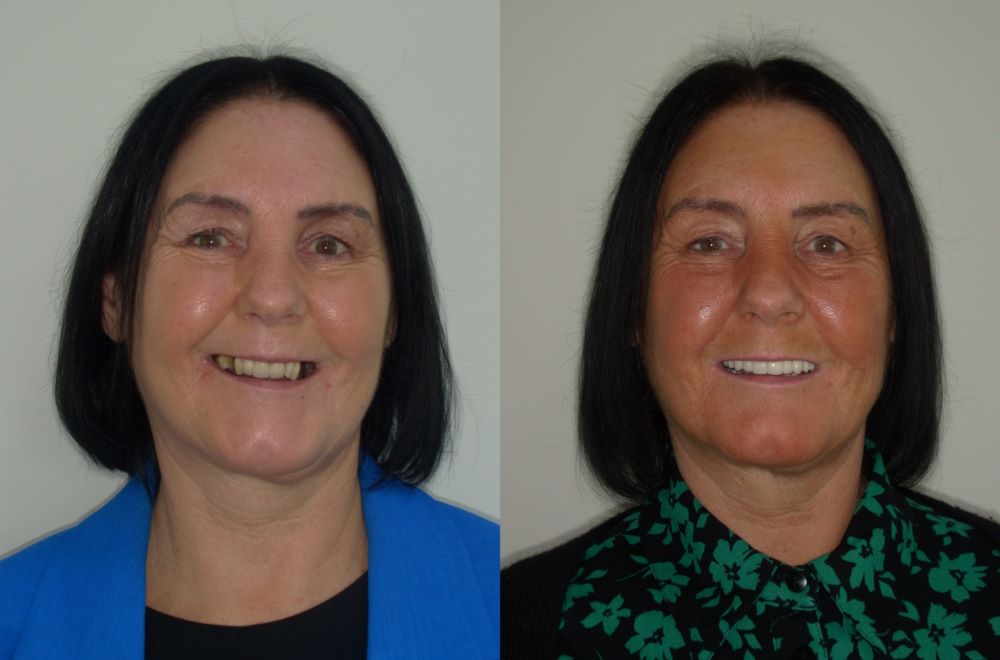
For years, Karen had been living with dental issues that progressively worsened. She was missing upper molars, which are crucial for effective chewing and overall mouth balance. Additionally, she had a bridge on her upper front teeth, but this solution was far from satisfactory. The bridge, meant to mask the absence of teeth, did little to restore the full functionality of her bite. Over time, other teeth began to wobble, and some were lost, further deteriorating her dental health. One of her remaining teeth became infected, leading to severe pain and the need for antibiotics. Yet, despite the discomfort and clear signs of worsening oral health, Karen’s overwhelming fear of dental procedures prevented her from allowing her dentist to extract the infected tooth. She feared that each dental intervention would lead her to lose more teeth, which filled her with dread.
Karen’s dental condition severely impacted her quality of life. Her inability to chew properly made eating a difficult and often painful task. This limitation affected her nutrition and enjoyment of food, casting a shadow over social interactions and meals, which are typically joyous, communal activities. Moreover, the constant awareness of her problematic teeth led Karen to feel deeply self-conscious about her appearance. She was embarrassed by her smile and avoided showing her teeth whenever possible.
Her emotional distress regarding her dental health spiralled into a broader sense of despair and depression. Karen felt trapped by her dental issues and her fears, which seemed insurmountable. It was in this state of despondency that she revisited the possibility of dental implants during discussions with her dentist. After thorough consultations, it became evident that implants were not just the best but perhaps the only option capable of fundamentally addressing her dental problems and fears.
The decision to consider implants was a significant step forward for Karen, but it was not made lightly. Her anxiety about dental procedures extended to IV sedation—a common practice intended to ease patient discomfort during invasive treatments. The thought of being sedated was as terrifying to her as the dental procedures themselves. She worried about the risks and the feeling of losing control, common concerns among patients with dental phobia.
Recognizing her apprehensions, Karen’s dentist suggested she consult with Fusion Dentistry, known for its expertise in handling complex dental cases and its empathetic approach to patient care. When Karen first visited Fusion, she was met with a team of professionals who were not only skilled in dental surgery but also deeply understanding of her fears and emotional state. They provided a safe space where Karen felt heard and supported, a contrast to her previous dental experiences which had often felt rushed and insensitive to her anxiety.
The team at Fusion Dentistry worked closely with Karen to design a treatment plan tailored to her needs. This plan was detailed and clear, outlining every step of the process, from the initial preparations to the post-operative care. Understanding her nervousness about IV sedation, the staff took extra time to explain how sedation works, the safety measures in place, and how it would be administered by an experienced anaesthesiologist. They ensured Karen that she would be closely monitored throughout the procedure, addressing her fears of losing control and offering reassurance about her safety and comfort.
With a newfound understanding and trust in the process, Karen agreed to proceed with the dental implants. The day of the surgery marked a turning point in her life. Administered by skilled professionals, the IV sedation allowed her to undergo the procedure without the distress and pain she had feared so much. The implants, placed where her molars were missing and designed to support a new bridge for her upper front teeth, were installed without complications.
The recovery process was an education in itself for Karen. Supported by the caring team at Fusion, she learned how to care for her new implants and adapt to the changes in her mouth. Over the weeks that followed, as she healed, Karen noticed a dramatic improvement in her ability to eat and speak comfortably. The stability of the implants contrasted sharply with her previous experiences of wobbling and missing teeth. Her smile, once a source of embarrassment, began to fill her with pride.
